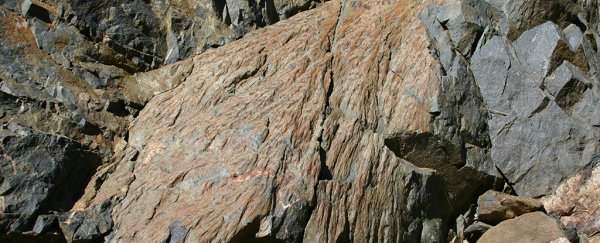Meteor impact sites might seem like easy things to recognize, with giant craters in Earth's surface showing where these far-flung objects finally came to a violent stop. But it's not always that way.
Sometimes those impact scars are healed over, disguised by layers of dirt and vegetation, or worn smooth again by the elements over vast stretches of time. Now scientists have found a way to detect these hidden impact sites.
Think about a big chunk of space rock getting close to its final destination on Earth. Meteoroids can enter Earth's atmosphere as fast as 72 kilometers per second (160,000 mph), but they do start to slow down as they move through our relatively dense atmosphere.
The beautiful light in the sky when a meteor flies overhead is due to 'ablation' – as layers and layers of the meteoroid are vaporized via high-speed collisions with air molecules.
Then, if the space rock makes it all the way to the ground, it collides with Earth, creating shatter cones, impact craters, and other tell-tale signs that a meteorite hit right here.
This is an intense geological process, with high temperatures, high pressures, and fast particle velocities all coinciding. One of the things that happens during this intense process is that the impact forms plasma – a type of gas in which atoms are broken into electrons and positive ions.
"When you have an impact, it's at a tremendous velocity," says geologist Gunther Kletetschka from the University of Alaska Fairbanks.
"And as soon as there is a contact with that velocity, there is a change of the kinetic energy into heat and vapor and plasma. A lot of people understand that there is heat, maybe some melting and evaporation, but people don't think about plasma."
What the team found here was that all that plasma did something weird to the normal magnetism of the rocks, leaving an impact area where the magnetism was around 10 times less than what natural levels of magnetization would ordinarily be.
Natural remanent magnetization is the amount of natural magnetism found in rocks or other sediment.
As Earth's sediment gradually settled after being laid down, the tiny grains of magnetic metals within it aligned themselves along the lines of the planet's magnetic field. These grains then remain trapped in their orientations within the solidified rock.
This is a very low amount of magnetization – about 1-2 percent of the rock's 'saturation level', and you can't tell by using a regular magnet, but it's definitely there, and can be measured pretty easily by geological equipment.
However, when a shockwave happens – like in a meteorite impact – there's a loss of magnetism, as the magnetic grains get a good blast of energy.
"The shock wave provides energy that exceeds the energy (> 1 GPa for magnetite > 50 GPa for hematite) required to block the magnetic remanence within individual magnetic grains," the researchers write in a new study.
Normally the shockwave would pass and the rocks would go back to their original level of magnetism almost immediately. But as the team found in the 1.2-billion-year-old Santa Fe impact structure in New Mexico, the magnetism never went back to its normal state.
Instead – they suggest – the plasma created a 'magnetic shield' that kept the grains in their jostled state, and the grains just kind of randomly orientated themselves. This caused the magnetic intensity to drop to 0.1 percent of the rock's saturation level – a 10-fold reduction from the natural level.
"We present a support for a newly proposed mechanism where the shock wave appearance can generate magnetic shielding that allow keeping the magnetic grains in a superparamagnetic-like state shortly after the shock's exposure, and leaves the individual magnetized grains in random orientations, significantly lowering the overall magnetic intensity," the team writes.
"Our data not only clarify how an impact process allows for a reduction of magnetic paleointensity but also inspire a new direction of effort to study impact sites, using paleointensity reduction as a new impact proxy."
Hopefully this new discovery will mean that scientists have another tool in their belt when it comes to finding impact sites, even ones that don't have the normal signs of impact, such as shatter cones or craters.
The research has been published in Scientific Reports.
